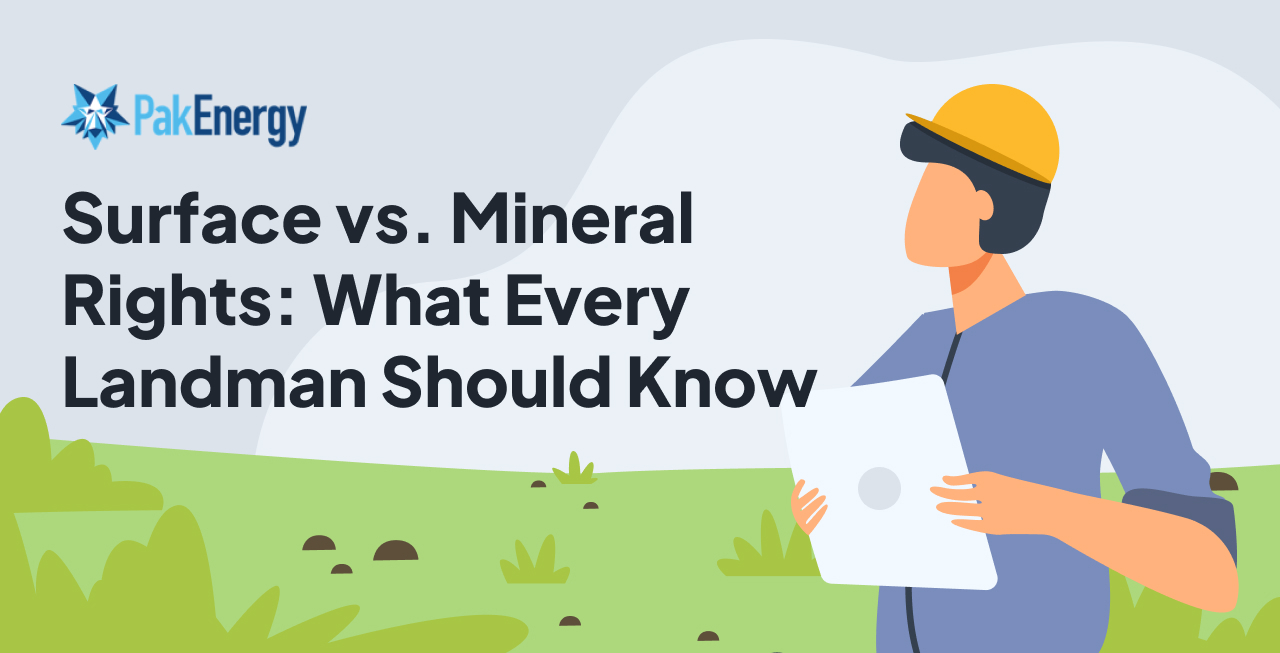
For landmen, understanding the distinction between surface and mineral rights is fundamental. Surface rights relate to the use of the land’s surface, while mineral rights determine ownership of the resources beneath it.
In today’s energy landscape—where operators often manage vast and complex asset portfolios—having a clear grasp of these rights is essential for effective land management. As the industry evolves, landmen can greatly benefit from modern land management software to help navigate the increasingly intricate web of ownership rights and ensure greater accuracy and efficiency.
What Are Mineral and Surface Rights?

Whenever land changes hands, ownership can be split between mineral rights and surface rights. Mineral rights refer to ownership of the resources beneath the property — oil, gas, coal, and other valuable metals and minerals. On the other hand, surface rights pertain to ownership of the surface level, including the rights to build a house and farm the land.
Landowners can sell or lease their surface rights while holding onto the mineral rights, or vice versa. When different entities own a property’s surface and mineral rights, it’s known as a split estate. In regions where oil and gas are prevalent, this division of rights is relatively commonplace.
How Do These Rights Affect Oil and Gas Land Administration?

The difference between surface and mineral rights informs a landman’s title research and lease negotiations in the following ways:
- Landmen will likely encounter plenty of scenarios where a property owner holds the surface rights but not the mineral rights. In these situations, the homeowner who lives on the land or the farmer who cultivates it has no authority over oil and gas activity on their property — that authority belongs to the mineral owner.
- Surface Use Negotiations: When operators acquire mineral rights leases, they often require surface access for drilling and infrastructure like building roads, developing drill site locations, laying pipelines, etc. This can require additional agreements with surface rights holders, further complicating negotiations regarding compensation and land use.
- Due Diligence: A crucial aspect of a landman’s job is conducting title research to see who owns what. Oil and gas land management software significantly simplifies ownership due diligence, allowing landmen to focus more on negotiations instead of poring over historical documentation.
Modern Land Management Solutions Can Help
Many of today’s landmen turn to oil and gas land management software to help them keep up with the fast-paced environment of the modern energy industry. Here’s what the best land management software can provide:
- Centralized Database: Quickly access ownership information, agreements, well records, and more.
- Geographic Information System (GIS) Mapping: Visually analyze in-house and third-party vendor data regarding surface and mineral rights boundaries, including negotiation stages.
- Automated Workflows: Streamline title research and document management with intuitive, collaborative workflow structures.
- Integrated Production and Financial Tools: The best land management software fosters collaboration between landmen, field staff, and accounting professionals, offering a streamlined solution for every stage of oil and gas operations.
PakEnergy: Your Go-To Partner for the Entire Land Lifecycle
The distinction between surface and mineral rights is a core concept for oil and gas operators looking for new lease opportunities. Land management software can help landmen navigate a complex web of ownership rights, adding efficiency to title research and due diligence.
PakEnergy delivers comprehensive, end-to-end land management software solutions supporting the entire land lifecycle, including plenty of helpful tools for landmen. If you want to learn how PakEnergy can level up your oil and gas operations, reach out today to book a free demo.
Discover how land teams can transform their operations and stay ahead of the competition with modern technology solutions in this free eBook »
